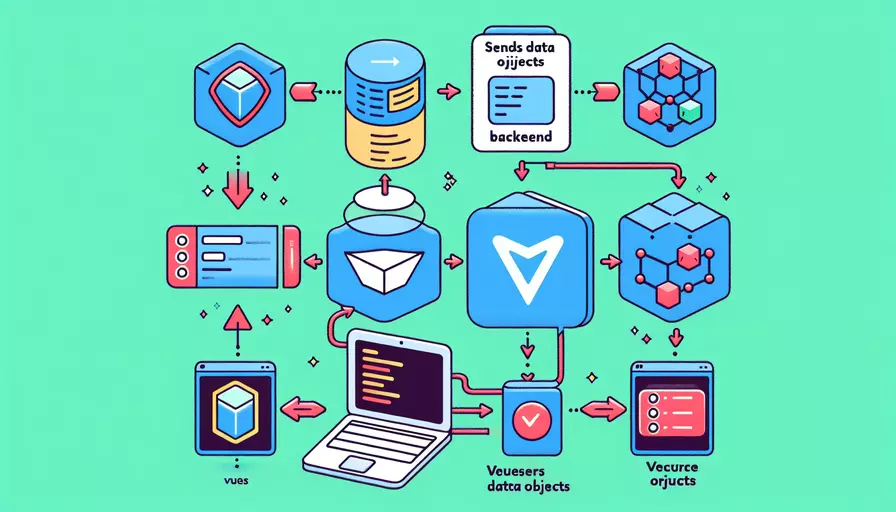
1、使用axios发送POST请求
在Vue中,可以使用axios库来向后端发送对象。axios是一款基于Promise的HTTP库,能够很方便地与后端进行通信。通过安装axios并在组件中引入、使用axios.post方法将对象发送到后端。
一、安装和引入axios
首先,需要安装axios库,并在Vue组件中进行引入。
npm install axios
然后,在Vue组件中引入axios:
import axios from 'axios';
二、定义对象和发送POST请求
接下来,定义一个对象,并使用axios.post方法将其发送到后端。
export default {
data() {
return {
user: {
name: 'John Doe',
age: 30,
email: 'john.doe@example.com'
}
};
},
methods: {
sendUserData() {
axios.post('https://your-backend-api.com/users', this.user)
.then(response => {
console.log('User data sent successfully:', response.data);
})
.catch(error => {
console.error('There was an error sending the user data:', error);
});
}
}
};
在上述代码中,定义了一个user对象,并使用axios.post方法将其发送到后端API。axios.post方法的第一个参数是后端API的URL,第二个参数是要发送的对象。
三、处理响应和错误
在axios.post方法中,使用.then和.catch方法分别处理成功的响应和错误。
- then方法:当请求成功时,会执行传递给then方法的回调函数,回调函数的参数是后端返回的响应数据。
- catch方法:当请求失败时,会执行传递给catch方法的回调函数,回调函数的参数是错误信息。
四、使用表单提交对象
除了直接在代码中定义对象并发送,还可以通过表单收集用户输入,然后将表单数据作为对象发送到后端。
export default {
data() {
return {
user: {
name: '',
age: '',
email: ''
}
};
},
methods: {
submitForm() {
axios.post('https://your-backend-api.com/users', this.user)
.then(response => {
console.log('Form data sent successfully:', response.data);
})
.catch(error => {
console.error('There was an error sending the form data:', error);
});
}
}
};
在模板中,可以使用v-model指令将表单字段与user对象的属性绑定:
<template>
<form @submit.prevent="submitForm">
<div>
<label for="name">Name:</label>
<input type="text" id="name" v-model="user.name">
</div>
<div>
<label for="age">Age:</label>
<input type="number" id="age" v-model="user.age">
</div>
<div>
<label for="email">Email:</label>
<input type="email" id="email" v-model="user.email">
</div>
<button type="submit">Submit</button>
</form>
</template>
在上述代码中,使用表单收集用户输入,并将其绑定到user对象的属性。表单提交时,调用submitForm方法,将user对象发送到后端。
五、使用Vuex进行状态管理
在复杂的应用中,可以使用Vuex进行状态管理,将对象存储在Vuex的状态中,并在需要时发送到后端。
首先,安装并配置Vuex:
npm install vuex
然后,在store.js中定义状态和actions:
import Vue from 'vue';
import Vuex from 'vuex';
import axios from 'axios';
Vue.use(Vuex);
export default new Vuex.Store({
state: {
user: {
name: '',
age: '',
email: ''
}
},
mutations: {
SET_USER(state, user) {
state.user = user;
}
},
actions: {
sendUserData({ state }) {
return axios.post('https://your-backend-api.com/users', state.user)
.then(response => {
console.log('User data sent successfully:', response.data);
})
.catch(error => {
console.error('There was an error sending the user data:', error);
});
}
}
});
在Vue组件中使用Vuex:
export default {
computed: {
user() {
return this.$store.state.user;
}
},
methods: {
updateUser(newUser) {
this.$store.commit('SET_USER', newUser);
},
sendUserData() {
this.$store.dispatch('sendUserData');
}
}
};
在模板中,可以使用v-model指令将表单字段与Vuex状态中的user属性绑定:
<template>
<form @submit.prevent="sendUserData">
<div>
<label for="name">Name:</label>
<input type="text" id="name" v-model="user.name">
</div>
<div>
<label for="age">Age:</label>
<input type="number" id="age" v-model="user.age">
</div>
<div>
<label for="email">Email:</label>
<input type="email" id="email" v-model="user.email">
</div>
<button type="submit">Submit</button>
</form>
</template>
通过这种方式,可以将对象存储在Vuex的状态中,并在需要时发送到后端。
六、使用拦截器处理请求和响应
为了统一处理请求和响应,可以使用axios的拦截器。拦截器可以在请求发送前和响应到达前对其进行处理。
axios.interceptors.request.use(
config => {
// 在请求发送前做些什么
console.log('Request:', config);
return config;
},
error => {
// 处理请求错误
return Promise.reject(error);
}
);
axios.interceptors.response.use(
response => {
// 对响应数据做些什么
console.log('Response:', response);
return response;
},
error => {
// 处理响应错误
return Promise.reject(error);
}
);
通过使用拦截器,可以在请求和响应的不同阶段进行统一的处理,如添加请求头、处理错误信息等。
总结
通过使用axios库,可以轻松地在Vue中向后端发送对象。主要步骤包括:1、安装和引入axios;2、定义对象并发送POST请求;3、处理响应和错误;4、使用表单提交对象;5、使用Vuex进行状态管理;6、使用拦截器处理请求和响应。通过这种方式,可以方便地与后端进行通信,并处理各种场景下的请求和响应。建议在实际应用中,根据具体需求选择合适的方式,并灵活使用axios的各种功能来实现更复杂的操作。
相关问答FAQs:
1. Vue如何向后端传递对象?
在Vue中向后端传递对象有多种方法,下面列举了两种常用的方式:
使用axios发送POST请求:
可以使用axios库来发送HTTP请求,包括向后端传递对象的POST请求。首先,需要在Vue项目中安装axios,然后在Vue组件中引入axios,并使用它发送POST请求。
示例代码如下:
<template>
<div>
<!-- 表单输入 -->
<input type="text" v-model="name">
<input type="text" v-model="email">
<button @click="submitForm">提交</button>
</div>
</template>
<script>
import axios from 'axios';
export default {
data() {
return {
name: '',
email: ''
};
},
methods: {
submitForm() {
// 创建一个对象,包含要传递给后端的数据
const data = {
name: this.name,
email: this.email
};
// 使用axios发送POST请求
axios.post('/api/endpoint', data)
.then(response => {
// 请求成功后的处理逻辑
console.log(response.data);
})
.catch(error => {
// 请求失败后的处理逻辑
console.error(error);
});
}
}
};
</script>
这段代码中,我们首先在data中定义了一个name和email属性,然后在submitForm方法中创建了一个包含name和email的对象。接下来,我们使用axios.post方法发送POST请求,并将数据对象作为第二个参数传递给该方法。在成功或失败的回调函数中,我们可以根据后端返回的数据进行相应的处理。
使用表单提交:
另一种常用的方法是使用表单提交来向后端传递对象。在Vue组件中,可以使用<form>标签和<input>标签来创建表单,并使用<button type="submit">来触发表单提交。
示例代码如下:
<template>
<div>
<form @submit="submitForm">
<!-- 表单输入 -->
<input type="text" v-model="name">
<input type="text" v-model="email">
<button type="submit">提交</button>
</form>
</div>
</template>
<script>
export default {
data() {
return {
name: '',
email: ''
};
},
methods: {
submitForm(event) {
event.preventDefault(); // 阻止表单默认提交行为
// 创建一个对象,包含要传递给后端的数据
const data = {
name: this.name,
email: this.email
};
// 在这里可以使用其他方式,如fetch API或XMLHttpRequest来发送POST请求
// ...
// 清空表单
this.name = '';
this.email = '';
}
}
};
</script>
在这段代码中,我们使用<form>标签创建了一个表单,并在<form>标签上监听了submit事件。在submitForm方法中,我们首先使用event.preventDefault()方法阻止表单的默认提交行为,然后创建一个包含name和email的对象。接下来,我们可以使用其他方式(如fetch API或XMLHttpRequest)来发送POST请求,根据具体需求进行相应的处理。
以上是两种常用的方法,可以根据具体情况选择适合自己项目的方式来向后端传递对象。
文章标题:vue如何向后端传对象,发布者:worktile,转载请注明出处:https://worktile.com/kb/p/3657614

 微信扫一扫
微信扫一扫  支付宝扫一扫
支付宝扫一扫 